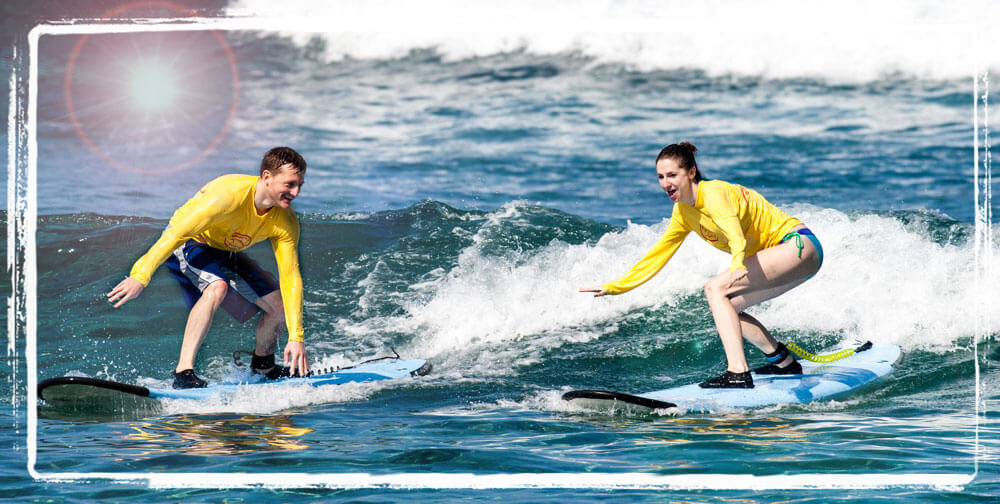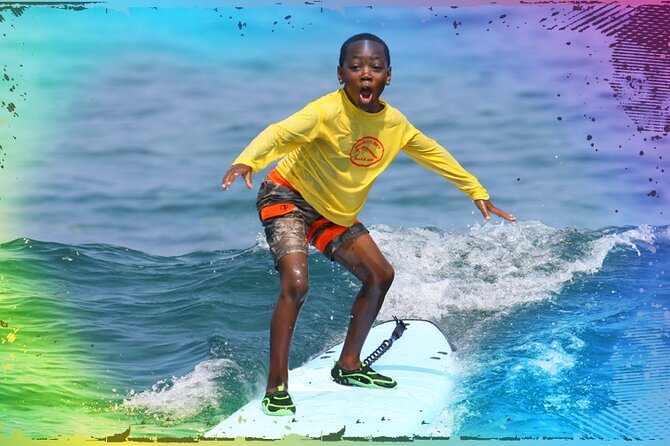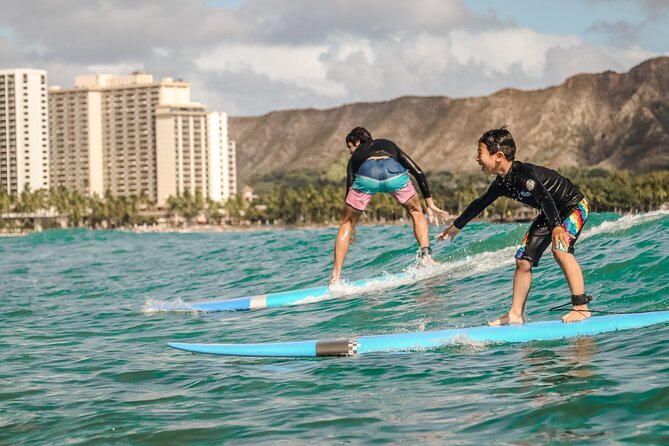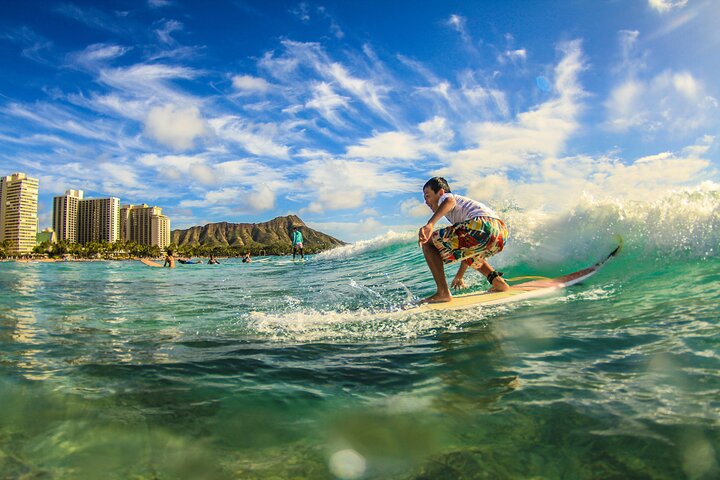Are you ready to catch some epic waves in the beautiful paradise of Hawaii? Well, look no further because we have the answer to your question! Hawaii offers an abundance of incredible surf spots, making it the perfect destination for surf enthusiasts of all levels. Whether you’re a beginner looking to catch your first wave or a seasoned pro searching for the ultimate thrill, Hawaii has it all. From the legendary waves of Waikiki to the picturesque shores of Maui, there are plenty of surf schools and experienced instructors ready to guide you through the exhilarating world of surfing. So grab your board, slather on some sunscreen, and get ready for the ride of a lifetime in Hawaii! Hawaii is an absolute paradise for surfers, with its breathtaking beaches, warm waters, and consistent waves. Whether you’re a seasoned pro or a beginner looking to catch your first wave, Hawaii offers an array of world-class surf spots that cater to all skill levels. In this article, we will explore the best surf spots in Hawaii, provide information on top-notch surfing schools, offer tips for beginners, delve into the best time to learn, highlight safety precautions, discuss surfing etiquette, and even touch upon other exciting water activities. So grab your board and let’s dive in!
Best Surf Spots in Hawaii
North Shore of Oahu
The world-renowned North Shore of Oahu is a mecca for surfers. From the iconic Banzai Pipeline to Waimea Bay, this stretch of coastline is home to some of the most challenging and prestigious surf breaks in the world. These powerful, barreling waves are not for the faint of heart, making them ideal for experienced surfers. If you’re up for the challenge, the North Shore of Oahu will leave you in awe of its beauty and thrill.
Maui
Maui, known as the “Valley Isle,” offers a variety of surf breaks suitable for surfers of all levels. Honolua Bay, situated on the northwest side of the island, is a favorite among experienced surfers due to its large waves and long rides. For beginners, the mellow breaks of Lahaina and Kihei provide the perfect opportunity to learn the art of riding waves. With its stunning landscapes and consistent surf, Maui is an idyllic destination for a memorable surfing adventure.
Kauai
Kauai, the “Garden Isle,” is a haven for nature lovers and surf enthusiasts alike. Hanalei Bay, located on the north shore of Kauai, is a legendary surf spot that boasts consistent swells and stunning surroundings. The gentle waves of Hanalei Bay are great for beginners and intermediate surfers looking to hone their skills. If you’re seeking a laid-back surfing experience in a picturesque setting, Kauai is the place to be.
Big Island
The Big Island of Hawaii may be famous for its active volcanoes and lush rainforests, but it also offers fantastic surf breaks. The Pohoiki area, located on the east side of the island, is home to one of the newest black sand beaches in Hawaii and offers both beginner and advanced surf spots. The strong currents and powerful waves at Honolii Beach Park on the northeast coast attract experienced surfers looking for a thrilling ride. For a unique surfing adventure, exploring the surf breaks on the Big Island is a must.
Surfing Schools in Hawaii
Oahu Surfing Experience
If you’re looking for a memorable surfing experience on the island of Oahu, Oahu Surfing Experience has got you covered. With experienced instructors and a passion for sharing the stoke of surfing, they offer lessons for all skill levels. Whether you’re a complete beginner or looking to fine-tune your skills, their personalized approach ensures a safe and enjoyable learning experience.
Mokulele Airlines Surf School
For those seeking a more immersive surf experience, Mokulele Airlines Surf School provides surf adventures that combine transportation and lessons. Fly from Oahu to the stunning island of Maui and learn to ride the waves in one of the world’s most renowned surf locations. With their knowledgeable instructors and all-inclusive packages, Mokulele Airlines Surf School offers a seamless and unforgettable surfing journey.
Maui Surfer Girls
As the first all-female surf school in Maui, Maui Surfer Girls offers a unique and empowering experience for women of all ages. Their team of skilled female instructors creates a supportive and inclusive environment to help you develop your surfing skills. Whether you’re a beginner or already have some experience, Maui Surfer Girls will guide you through the waves while fostering a sense of camaraderie and empowerment.
Kauai Surf School
Immerse yourself in the beauty of Kauai’s surf scene with Kauai Surf School. Their experienced instructors provide personalized lessons tailored to your skill level and goals. Whether you’re looking to catch your first wave or enhance your technique, Kauai Surf School provides a safe and enjoyable learning experience amidst the stunning surroundings of Kauai.

Explore Uncharted Hawaiian Destinations
What to Expect in a Surf Lesson
Basic Techniques
In a surf lesson, you can expect to learn the fundamental techniques necessary for riding waves. These include proper paddling, how to stand up on the board, and finding balance while riding the wave. Your instructor will guide you through each step, ensuring you have a solid foundation to build upon.
Safety Tips
Safety is of utmost importance in any surf lesson. You can expect your instructor to teach you how to assess ocean conditions, recognize and navigate potential hazards, and understand proper etiquette in the lineup. Understanding and respecting surf etiquette helps maintain a safe and enjoyable experience for all surfers.
Equipment Rental
Most surf schools provide all the necessary equipment for your lesson, including a surfboard and leash. You can expect your instructor to assist you in selecting the right board for your skill level and body type. They will also teach you how to properly handle and care for your equipment.
Choosing the Right Surf School
Certification and Experience
When selecting a surf school, it’s important to consider their certification and experience. Look for schools that are accredited by recognized surfing associations, such as the International Surfing Association (ISA). Additionally, inquire about the experience and qualifications of the instructors to ensure you receive quality instruction.
Student-to-Instructor Ratio
A low student-to-instructor ratio allows for more personalized attention and feedback during your lesson. Aim for surf schools that maintain small class sizes to ensure you receive individualized instruction and guidance. This allows instructors to focus on addressing your specific needs and helping you progress at your own pace.
Instructor Qualifications
Confirm that the instructors at your chosen surf school hold relevant certifications, such as lifeguard training or surf instructor qualifications. These qualifications indicate that the instructors possess the necessary skills and knowledge to provide a safe and effective learning environment.

Plan Your Dream Hawaiian Getaway
Booking a Surf Lesson
Online Reservations
Many surf schools offer the convenience of online reservations, allowing you to secure your spot in advance. Online reservations provide the flexibility to choose the date and time that works best for you, ensuring a seamless booking process. It’s advisable to book your surf lesson in advance, especially during peak seasons, to guarantee availability.
Walk-ins
If you prefer a more spontaneous approach, some surf schools may accommodate walk-ins, depending on availability. However, it’s recommended to call ahead or check the surf school’s website to confirm walk-in policy and availability, particularly during busier times.
Group vs. Private Lessons
Surf schools typically offer both group and private lessons. Group lessons provide a fun and engaging environment where you can learn alongside other surf enthusiasts. Private lessons, on the other hand, offer one-on-one instruction, allowing for personalized attention and a more tailored learning experience. Consider your preferred learning style and budget when deciding between group and private lessons.
Surfing Tips for Beginners
Picking the Right Board
As a beginner, selecting the right surfboard is crucial. Start with a longer and wider board, known as a “longboard,” as they offer greater stability and buoyancy. These characteristics make it easier to catch waves and maintain balance, providing an ideal platform for learning the basics of surfing.
Learning How to Paddle
Mastering the art of paddling is essential for successful surfing. Practice proper paddle technique, using your arms to propel yourself through the water efficiently. As you gain strength and experience, you’ll be able to navigate the waves more effectively and catch waves with greater ease.
Understanding Wave Sets
Understanding wave sets is critical for timing your entry into the lineup and catching waves. Watch the patterns of incoming waves and identify sets of waves that arrive in consecutive groups. Ride the first wave of a set and paddle back out during the lull between sets to conserve your energy and maximize your time in the water.

Experience Hawaii’s Unique Attractions
Best Time to Learn Surfing in Hawaii
Swells and Seasons
The best time to learn surfing in Hawaii depends on the swell conditions and seasons. Winter months, specifically from November to February, bring larger swells to the islands, making it more challenging for beginners. Spring and summer, from March to September, offer smaller and more manageable waves, providing an ideal learning environment.
Crowded vs. Uncrowded Beaches
Consider choosing uncrowded or less-popular beaches for your surf lessons, especially as a beginner. Less crowded beaches provide a more relaxed and supportive atmosphere, allowing you to practice and learn without feeling overwhelmed. Popular tourist destinations may have more crowded lineups where experienced surfers dominate, making it less ideal for beginners.
Safety Precautions for Surfing
Sun Protection
When spending extended periods in the water, it’s crucial to prioritize sun protection. Apply waterproof sunscreen with a high SPF, wear a wide-brimmed hat, and consider wearing a rash guard to shield your skin from harmful UV rays. Protecting yourself from the sun’s harsh rays ensures a safe and enjoyable surfing experience while minimizing the risk of sunburn or skin damage.
Understanding Rip Currents
Rip currents are powerful channels of water that flow away from the shore, often perpendicular to the beach. It’s important to educate yourself about rip currents and how to identify them to avoid potentially dangerous situations. If caught in a rip current, stay calm, swim parallel to the shore, and use the conservation of energy until you’re out of the current’s pull.
Being Aware of Local Rules
Different beaches may have specific rules and regulations regarding surfing, such as designated surf zones or restricted areas. Familiarize yourself with these rules before entering the water to ensure you’re respecting local guidelines and maintaining a safe environment for yourself and others.

Surfing Etiquette in Hawaii
Respecting the Locals
When surfing in Hawaii, it’s essential to respect the local surf culture and its unwritten rules. Give the locals their space and wait your turn in the lineup. It’s important to be mindful of the locals’ dominance in popular surf spots and to avoid overcrowding the lineup as a visiting surfer.
Sharing Waves
Sharing waves is a fundamental aspect of surfing etiquette. Respect the order of lineup and wait your turn for a wave. Avoid dropping in on fellow surfers by not paddling for a wave if someone is already riding it. Sharing waves with respect fosters a positive and friendly atmosphere in the lineup.
Taking Turns
Take turns in the lineup and avoid being too aggressive or hogging the waves. Wait your turn patiently, and be mindful of others in the water. By practicing turn-taking, you contribute to a harmonious and enjoyable surfing experience for everyone.
Other Water Activities in Hawaii
Stand Up Paddleboarding
If you’re looking for a water activity that offers a unique perspective and a full-body workout, stand-up paddleboarding (SUP) is a fantastic option. Glide atop Hawaii’s crystal-clear waters, taking in the stunning scenery while improving your balance and core strength. SUP is suitable for all ages and skill levels, making it a great choice for those seeking an alternative to traditional surfing.
Snorkeling
Immerse yourself in Hawaii’s underwater paradise through snorkeling. With its vibrant coral reefs and diverse marine life, Hawaii offers some of the best snorkeling spots in the world. Grab your mask, snorkel, and fins, and explore the mesmerizing world beneath the surface. Remember to respect the fragile ecosystem by avoiding touching or stepping on corals and marine life.
Kayaking
Embark on a kayaking adventure and discover Hawaii’s hidden gems from a different perspective. Paddle along the coastline, explore secluded coves, and witness the breathtaking beauty of the islands. Kayaking is a fantastic way to engage with nature while enjoying a fun and rewarding water activity.
In conclusion, Hawaii is a surfer’s paradise, offering a wide range of surf spots, top-notch surf schools, and incredible opportunities for everyone, from beginners to seasoned veterans. By choosing the right surf school, understanding the basics of surfing, considering timing and safety precautions, and adhering to proper surf etiquette, you can fully immerse yourself in the exhilarating experience of riding the waves in Hawaii. And don’t forget to explore other thrilling water activities like stand-up paddleboarding, snorkeling, and kayaking to make the most of your time in this tropical paradise. So grab your board, dive in, and let Hawaii’s majestic waves become your new playground. Aloha!
